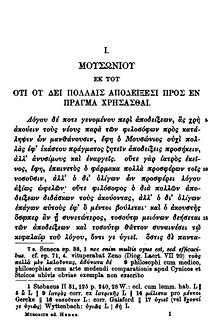Text-critical apparatus

The text-critical apparatus records the deviating variants of the main text in a historical-critical edition (HKA) of a work. Text-critical apparatus is necessary for scientific work if there are several different editions with different texts for a work, or if there are gaps, later revisions, corrections, comments or translations have changed the original text. With the help of the text criticism, the editor decides which text should be the so-called guiding manuscript and which text should be included as a comment in the text-critical apparatus. The device provides information about different versions and, if possible, explains how they came about. In contrast to this, editions without a text-critical apparatus are intended for general use and are referred to as reading editions .
The apparatus (lat. Apparatus "equipment") in the narrower sense records the variants from the history of transmission or origin of a text in critical editions . In a broader sense, it contains, as a separately printed part following an edited text, especially in the case of historical-critical editions of texts from recent literature, the description of all text carriers, the reasons for the choice of the text basis, the history of origin, the list of variants, reasons for the text form, a Documentation of the sources and the text reception during the author's lifetime as well as explanations (the commentary ).
Single station
This form of the apparatus is the simplest of the apparatus types. It is particularly suitable for corrections to the text that are not closely related. This makes it easy to show deviations between letters, copies and different prints. A distinction is made between the positive (lemmatized (Greek: lemma = received) apparatus) and the negative apparatus. In the case of the positive apparatus, the reference word from the text is given in front of a square bracket (]) that is open to the left. Then there are the different variants.
As an example, a fictitious text: "The yellow (1) clock in Prague"
The device reads: (1) yellow] golden H²
H² is an abbreviation or sigel for a handwriting, which is explained in more detail in the apparatus. So it says in the handwriting H²: "The golden clock in Prague". The publisher has chosen “The yellow (1) clock in Prague”.
In the case of the negative apparatus, the reference word is omitted. So the device for the same text would look like this: (1) golden H²
Fade-in device
The corrections are "displayed" in the text. Different forms of correction are identified, for example by dots under the letters, for letters that have been deciphered with certainty. These marks are called diacritical marks, but they can vary from edition to edition.
Staircase apparatus
This apparatus is useful if the author has made immediate corrections. The correction sequences are identified with an ascending sequence of numbers or letters. This makes the chronology clear. The advantage is that you can understand the individual work stages.
See also
literature
- Günther Schweikle, Irmgard Schweikle (Hrsg.): Metzler Literature Lexicon. 2nd revised edition. Metzler, Stuttgart 1990, ISBN 3-476-00668-9 .
- Bodo Plachta: Edition Studies. An introduction to the method and practice of editing newer texts . 2nd supplemented edition. Reclam, Stuttgart 2006, ISBN 3-15-017603-4